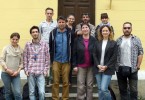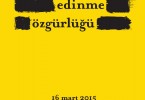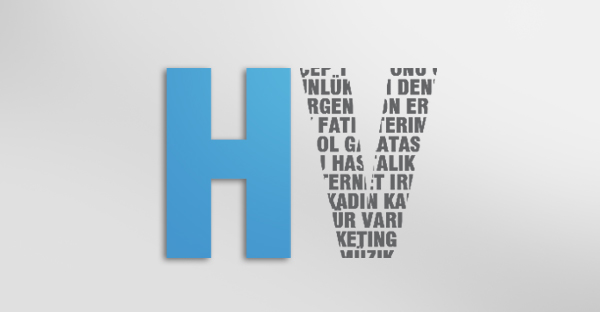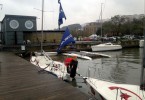Ferhat Jak Icoz
On a rainy fall day, with a friend we decided to spend our two-hour break at the Contemporary Arts Museum of SantralIstanbul, without knowing what was expecting us. My friend commented to persuade me that ‘the exhibition is quite striking, interesting, and even mind-blowing’.
As we approached to the end of our break, we were able to be done only with the first floor (top floor) of the exhibition, so I decided to come back for a more extensive and intensive exploration of Yuksel Arslan.
Yuksel Arslan, 76 year old artist, a controversial and intellectually futuristic figure, has exiled himself to Paris 40 years ago. During these 40 years, his fame flourished as an artist, however he remained quite mysterious for Turkish art-lovers. And after such a long exile, Arslan came back home, to Halic, where he was born, and now, where he has his retrospective exhibition, at the Contemporary Arts Museum of SantralIstanbul.
Doubtlessly, media loved the Turkish-drama like story of this man, who left his hometown as a poor, unknown artist, and is making a homecoming as an artist of international fame, after proving himself to be one of the most important art figures in the world.
Indeed, there is no need to barely mention about Arslan’s biographical story, as the exhibition arranged in a way, that you both learn about the biography of Arslan, witnessing the processes and evolutions, and sometimes revolutions, Arslan underwent, as an artist.
On the first floor of the exhibition (third floor), childhood and adolescence years of Arslan come up. As a child of factory worker from Anatolia, who fought at Balkan, Independence and WWI wars, he grew up in Eyup, where cemeteries dominate the view. Hence, gravestones were like toys to Arslan. Another great interest of Arslan’s was sexuality among animals. These two themes, gravestones and animal sexuality, are seen in the very first phase of his art life. He claims to be under great influence of Paul Klee during these years in terms of painting style.
Then, a rebel against ‘artificial’ paints arose in Arslan, and he tried to produce his own paints from different natural materials. With these newly self-discovered natural paints, he painted the series called ‘Homage to Relationships, Behavior, Boredom’, in which a great influence of Freud can be observed through pictured humanized animals in human action.
With the first money Arslan earned, he bought some art books, in which he learnt the ‘real’ formula of natural paints, which consisted of earth, honey, egg white, oil, bone marrow, urine, and blood.
Between 1956 and 1957, Arslan fell into a dry spell, and as a way out, he did compulsory military service in rural Eastern part of Turkey. Although he read Baudelaire, Rimbaud, and Marquis de Sade, he found his inspiration in village life in Eastern Turkey. Arslan painted a lot during his military service thematizing the village life of Eastern Turkey.
After the military service, between 1958 and 1961, Marquis de Sade, Baudelaire, Lautréamont, and Rimbaud made a come back to Arslan’s intellectual life. This new epoch in Arslan’s art life, which is called ‘Phallisme’ was dominated with erotic scenes, sexual drives, and sexual autobiographical accounts.
In 1961, Arslan made his first appearance in Paris’ art life, where he opened a very controversial exhibition, which needed to be visited on invitation.
Arslan coined the term arture, in contrast to art, for the first time in 1962. According to Arslan, arture is not real painting, but a creation combined of painting, writing, philosohpy, and poetry.
In Arslan’s artures up until 1967, a great deal of Nietzsche-isque thought is discernible. Arslan describes this period of his life as disgust for mankind, which he describes to be his greatest shortcoming. This disgust can be seen clearly in Arslan’s pieces; animal, plants, humans, all mixed, all in human action, living in cities, working, reproducing, but none of creatures Arslan had put on his artures belong to any category, they are just objects of disgust.
Arslan claims that for a long time he had been running away from subjects of Marxism, socialism, and communism. In 1969, when Arslan journeyed back to Turkey, his feelings of inferiority, stemming from his sense of belonging to a lower class choked up his productivity. This led him to work on Marxism. In this period called ‘Warning for the Capital’ between 1969 and 1975, Arslan created artures about big buildings, factories, cities in which small, insignificant, anonymous, but 100 % pure humans live, walk, or work, in contrast to mixed creatures in his earlier eras. In contrast with anonymous laborers, Arslan portrayed bosses with characteristics, as mainly monstrous mutants. Between 1975 and 1980, Arslan extended his works on Marxism under the name of ‘An Attempt to Updating ‘’The Capital’’.
‘Influences’ is Arslan’s next period, where he portrayed philosophers, scientists, and artists from prehistory up until today, who had an influence on his art and thought. Arslan describes this period as ‘a homage to whole humanity’ of all historical times, including today. As an extension of this period, Arslan painted autoartures, in which he identified himself with philosophers, scientists, and artists. After 2000, Arslan began to work on ‘New Influences’, in which he artfully describes his ‘friendships’ with these influential people.
Between 1986 and 2000, Arslan worked on anatomy of human. In this period, Arslan took nervous system, anatomy, reproductivity, pathology, psychopathology, and especially schizophrenia as subjects of his art. Glancing at artures of this period resembles like going through an arty anatomy or pathology book.







